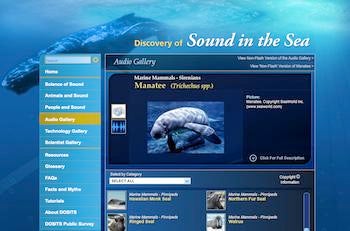 Audio, video, photos explain science of underwater sound
Audio, video, photos explain science of underwater sound
NARRAGANSETT, R.I. – July 27, 2010 – The Office of Marine Programs at the University of Rhode Island Graduate School of Oceanography has launched a redesigned website to introduce the public, teachers, and students to the science and uses of sound in the world ocean.
The website will be presented to the international marine acoustics community at a conference in Cork, Ireland in mid-August by the project director at URI, Gail Scowcroft, and her colleague Kathleen Vigness-Raposa, a marine biologist at Marine Acoustics, Inc. in Middletown.
Discovery of Sound in the Sea, the leading and most comprehensive website on underwater sound, provides an interactive audio gallery of sound recordings from more than 70 marine mammals, fish and invertebrates, as well as other natural sounds and man-made underwater sounds like ships, airguns and sonar. It also includes information about the science of underwater sound, how animals use and are affected by sound, and many other resources.
“Everyone and everything that works or lives in the ocean uses sound to sense their surroundings or communicate or navigate. Sound is used in the ocean like light is used in the air,” explained Vigness-Raposa.
The U.S. Office of Naval Research funded creation of the website in 2002 out of a concern over the general lack of understanding of the science of sound in the ocean. The new site replaces the original version with a refreshed look and a wide range of new interactive tools and features. The updated homepage now includes an interactive media player that allows users to explore a variety of content from within the website as well as play videos and listen to sound files.
“The new site has a more appealing look and plenty of features that will make it more engaging to use,” said Holly Morin, a URI marine research associate who collaborated on the development of the website. “It lets users dive deeper into the subjects in which they’re interested and highlights the diversity of images, videos and sound files to play.”
While many people are familiar with the sounds made by whales and other marine mammals, Morin noted that users of the website will be intrigued to learn about the sounds made by other creatures, such as the snapping shrimp.
“Snapping shrimp can often dominate the background noise in certain tropical oceans,” she said. “They quickly close their larger claw to produce a loud snapping sound as a way to stun their prey or deter predators. The sound made by some snapping shrimp is actually generated by the formation and subsequent popping of a bubble.”
Teachers and students use the site extensively. Feedback from the public has also been very positive. The original site received over 7 million hits a year and the project team expects the traffic to greatly increase with the much-improved site.
The site’s educational resources are used by teachers of all grades, including undergraduate faculty. “I use the DOSITS website in my acoustics courses,” said James Miller, URI professor of ocean engineering. “The material motivates my students to learn more about aspects of sound outside their discipline. For example, students can get an introduction to hearing in animals and also on the propagation of sound in the ocean.”
The development of the Discovery of Sound in the Sea website was funded by the Office of Naval Research with support from the National Science Foundation and the National Oceanic and Atmospheric Administration.

